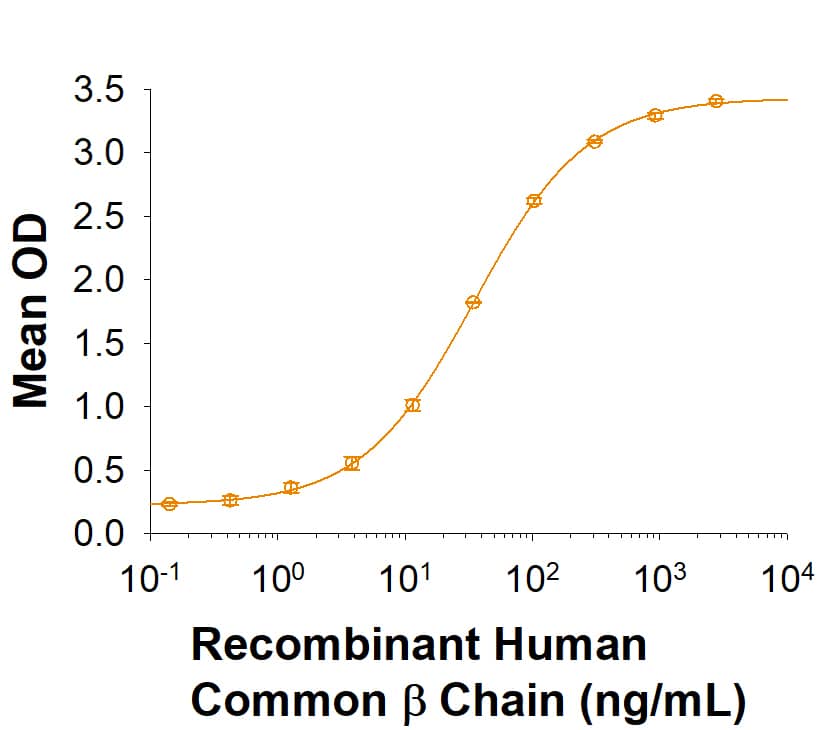Recombinant Human Common beta Chain His-tag Protein, CF
R&D Systems, part of Bio-Techne | Catalog # 9960-CB

Key Product Details
Product Specifications
Source
Mouse myeloma cell line, NS0-derived human Common beta Chain protein
Trp17-Trp443, with a C-terminal 6-His tag
Trp17-Trp443, with a C-terminal 6-His tag
Purity
>95%, by SDS-PAGE visualized with Silver Staining and quantitative densitometry by Coomassie® Blue Staining.
Endotoxin Level
<0.10 EU per 1 μg of the protein by the LAL method.
N-terminal Sequence Analysis
Gly23 & Glu25
Predicted Molecular Mass
49 kDa
SDS-PAGE
57-65 kDa, reducing conditions
Activity
Measured by its binding ability in a functional ELISA.
Recombinant Human Common beta Chain binds Recombinant Human GM‑CSF (Catalog # 215-GM) in the presence of Recombinant Human GM‑CSF R alpha (Catalog # 706-GR). The concentration of Recombinant Human Common beta that produces 50% of the optimal binding response is 20-120 ng/mL.
Recombinant Human Common beta Chain binds Recombinant Human GM‑CSF (Catalog # 215-GM) in the presence of Recombinant Human GM‑CSF R alpha (Catalog # 706-GR). The concentration of Recombinant Human Common beta that produces 50% of the optimal binding response is 20-120 ng/mL.
Scientific Data Images for Recombinant Human Common beta Chain His-tag Protein, CF
Recombinant Human Common beta Chain His-tag Protein SDS-PAGE
2 μg/lane of Recombinant Human Common beta Chain was resolved with SDS-PAGE under reducing (R) and non-reducing (NR) conditions and visualized by Coomassie® blue staining, showing bands at 57-65 kDa.Formulation, Preparation and Storage
9960-CB
| Formulation | Lyophilized from a 0.2 μm filtered solution in PBS. |
| Reconstitution | Reconstitute at 500 μg/mL in PBS. |
| Shipping | The product is shipped at ambient temperature. Upon receipt, store it immediately at the temperature recommended below. |
| Stability & Storage |
|
Background: Common beta Chain
References
- Lopez, A.F. et al. (2010) IUBMB Life 62:509.
- Hayashida, K. et al. (1990) Proc. Natl. Acad. Sci. USA 87:9655.
- Hansen, G. et al. (2008) Cell 134:496.
- Blake, T.J. et al. (2002) J. Leukoc. Biol. 72:1246.
- Brines, M. et al. (2004) Proc. Natl. Acad. Sci. USA 101:14907.
- Dentelli, P. et al. (2005) Oncogene 24:6394.
- Saulle, E. et al. (2009) Br. J. Haematol. 145:399.
- Lennartsson, J. et al. (2004) J. Biol. Chem. 279:44544.
- Uberti, B. et al. (2010) Oncogene 29:6581.
- Dirksen, U. et al. (1997) J. Clin. Invest. 100:2211.
Alternate Names
CD131, CSF2RB, GM-CSF R beta, IL-3 R beta, IL-5 R beta
Gene Symbol
CSF2RB
UniProt
Additional Common beta Chain Products
Product Documents for Recombinant Human Common beta Chain His-tag Protein, CF
Product Specific Notices for Recombinant Human Common beta Chain His-tag Protein, CF
For research use only
